Physical Address
304 North Cardinal St.
Dorchester Center, MA 02124
The nervous system is divided into central and peripheral divisions, along with the separate autonomic system. The central nervous system consists of the brain and spinal cord, while the peripheral nervous system consists of the nerves to the trunk and extremities.
The brain is composed of the hemispheres, the brainstem, and the cerebellum. The hemispheres are divided into the frontal, temporal, parietal, and occipital lobes. The frontal lobe houses higher personality and executive functions. The central sulcus marks the dividing line between the frontal and parietal lobes, with the primary motor cortex on the anterior aspect of this sulcus and the primary sensory cortex on the posterior border. The opercular cortex on the frontal side of the sylvian fissure in the dominant hemisphere houses the motor speech area (Broca’s area). The temporal lobe contains areas subserving memory (hippocampus), emotion and primitive urges (amygdala), hearing (primary auditory cortex, Heschel’s gyrus), and speech (dominant posterior temporal region). The parietal lobe serves both primary and complex sensory functions (graphesthesia) as well as cortical regions for speech comprehension (Wernicke’s area) and association. The occipital lobes are primarily involved with vision, containing both the primary and secondary visual regions. The hemispheres are connected by the fibers of the corpus callosum (see Fig. 3.1 ). The primary motor and sensory cortices are organized in a homuncular pattern, with the foot located in the interhemispheric fissure and the hip area arranged medially, with the medial-to-lateral organization of arm–hand–face–mouth (see Fig. 3.2 ).
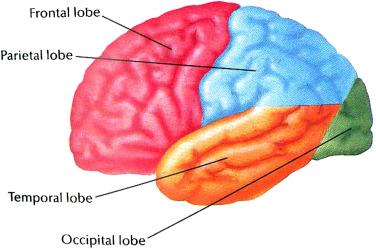
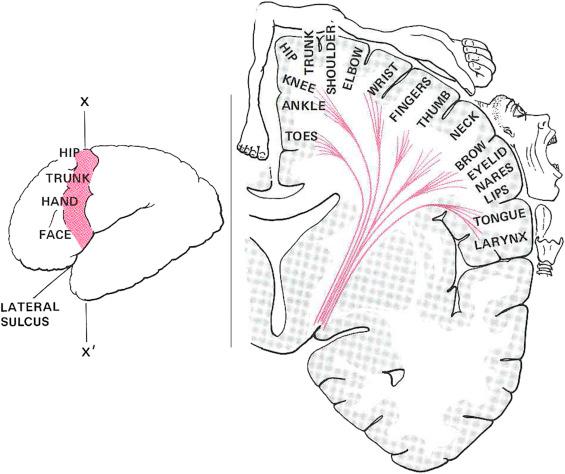
The basal ganglia are located deep within the hemispheres and comprise the c-shaped caudate nucleus, the putamen, and the globus pallidus (see Fig. 3.3 ).
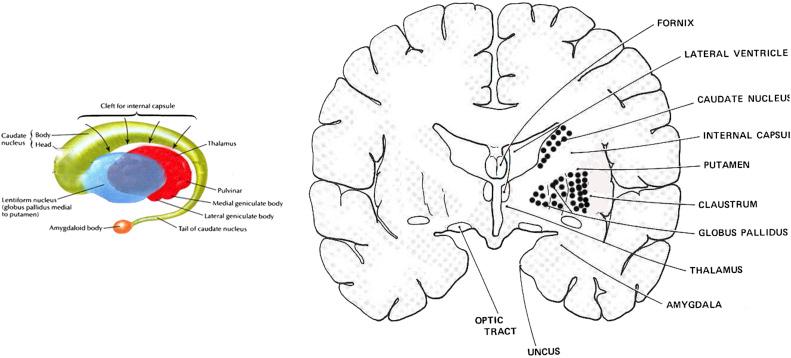
Some also include the amygdala in the temporal lobe in this group of structures. The caudate and putamen are connected by thin gray-matter bridges and together are termed the lentiform nucleus. The anterior limb of the internal capsule passes between these bridges. The connection between these structures is more robust ventromedially. The caudate follows the curve of the ventricular system, with the tail ending in the anterior temporal lobe near the amygdala. The globus pallidus is divided into internal and external segments, the globus pallidus interna and externa, respectively. The posterior limb of the internal capsule lies at the medial border of the globus pallidus. The basal ganglia are involved in the control of both cognitive and motor functions. They form a network of deep nuclei connected to each another and the cortex via both direct and indirect pathways through the thalamus. The nuclei of the basal ganglia form the basis of the extrapyramidal motor control system that modulates motor function.
The brainstem is further divided into the diencephalon (thalamic complex), the mesencephalon (midbrain), the metencephalon (pons), and the myelencephalon (medulla). The diencephalon includes the thalamus, which functions as a relay center for most motor and sensory tracts (aside from olfaction), the epithalamus (pineal, habenular nuclei, stria medullaris), which functions to control the diurnal cycle, the hypothalamus, which regulates multiple pituitary hormones via releasing factors as well as producing its own hormones (ADH, vasopressin), and the subthalamic nucleus, which participates in the extrapyramidal motor system along with the basal ganglia. The thalamus is bounded laterally by the posterior limb of the internal capsule and caudally by the midbrain. Within the thalamus, the ventrocaudal (V c ) nucleus (sometimes referred to as the ventral posterior or VP nucleus) is primarily responsible for relaying painful sensation.
The midbrain contains the nuclei for cranial nerves III and IV as well as the corticobulbar and corticospinal tracts carrying motor fibers from the cortex to the brainstem and spinal cord, respectively (see Fig. 3.4 in the cerebral peduncles).
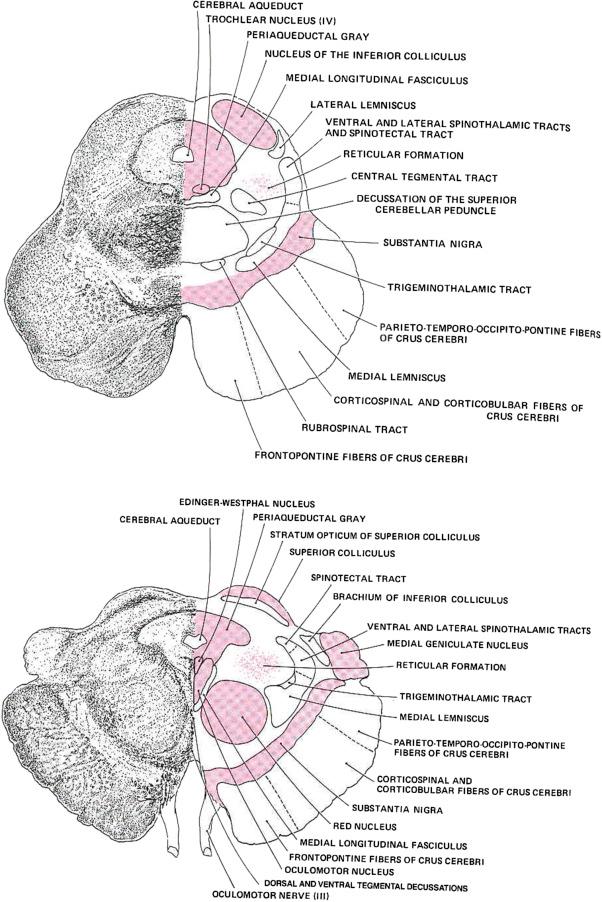
The fibers of the dentatorubrothalamic tract decussate in the midbrain after emerging from the superior cerebellar peduncle on their way to the red nucleus in the midbrain tegmentum and then on to the thalamus. The dorsal aspect (tectum) of the midbrain consists of the paired superior and inferior colliculi subserving coordination of vision and hearing, respectively. The pedunculopontine nucleus is also located here. This nucleus functions in the extrapyramidal motor system as part of the “locomotor center.” It has connections to the pallidum, cortex, and substantia nigra.
The pontine tegmentum is dominated by the crossing fibers of the middle cerebellar peduncles (see Fig. 3.5 ).

The pons contains the nuclei of cranial nerves V, VI, VII, and VIII. The facial colliculus is the bulge in the roof of the midbrain formed by the fibers of cranial nerve VII looping over the nucleus of cranial nerve VI. The brainstem anatomy of cranial nerve V is described in more detail below. The fourth ventricle lies between the roof of the pons and the ventral cerebellum. Cranial nerves III, IV, and VI control extraocular movement. Cranial nerve V controls facial sensation as well as masseter muscle function. Cranial nerve VII controls the muscles of facial expression and carries some of the parasympathetic fibers for salivation and tearing.
The medulla houses the nuclei of cranial nerves IX, X, XI, and XII. The pyramidal tracts decussate here. The nuclei cuneatus and gracilis for the spinal sensory tracts are located here as well. The caudal end of the medulla is continuous with the spinal cord (see Fig. 3.6 ).
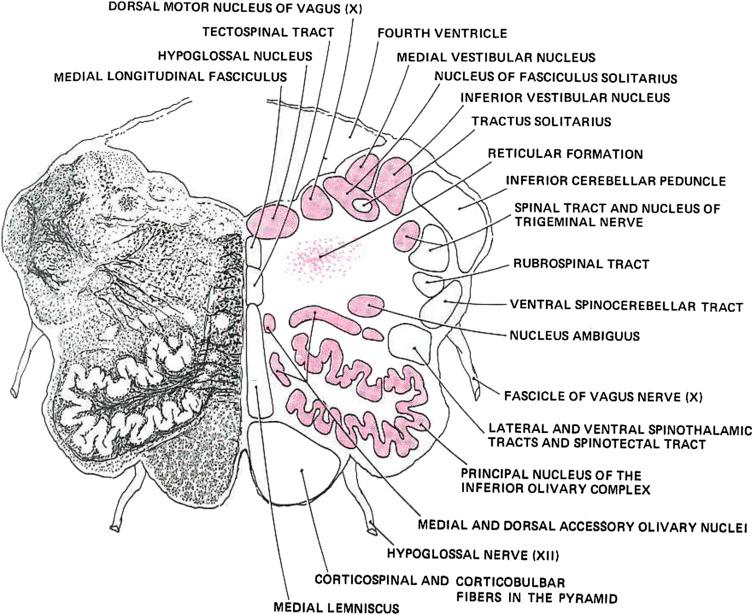
Become a Clinical Tree membership for Full access and enjoy Unlimited articles
If you are a member. Log in here